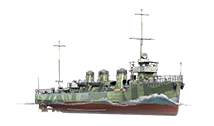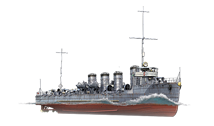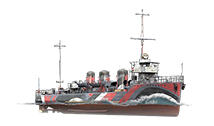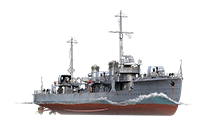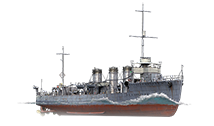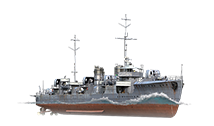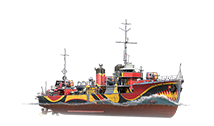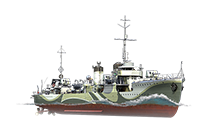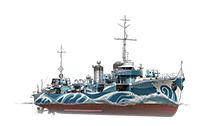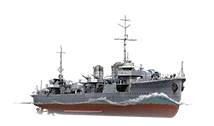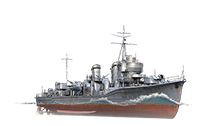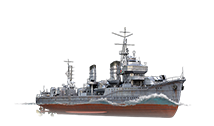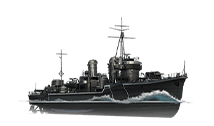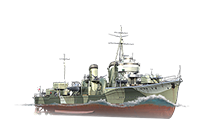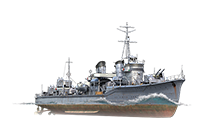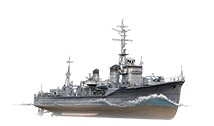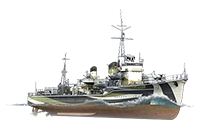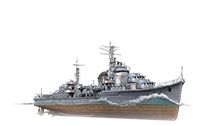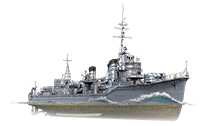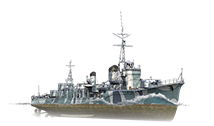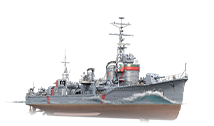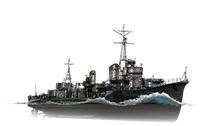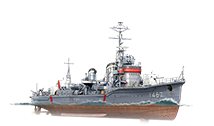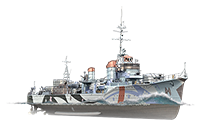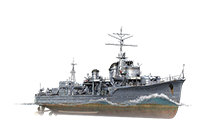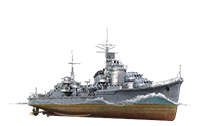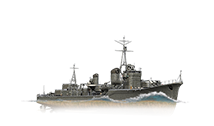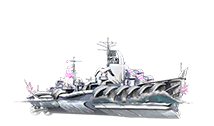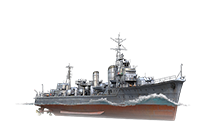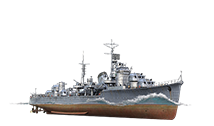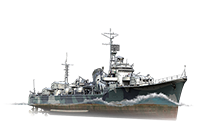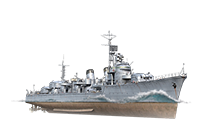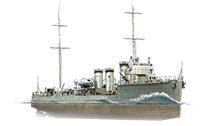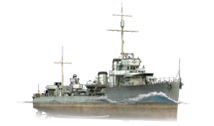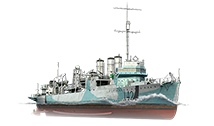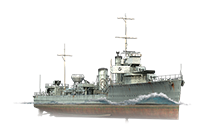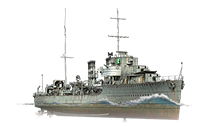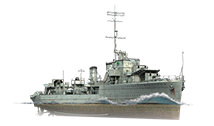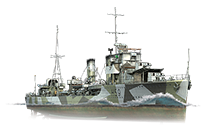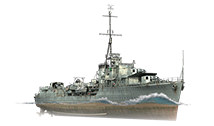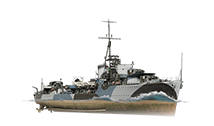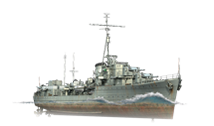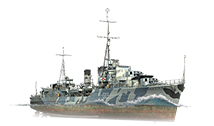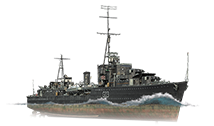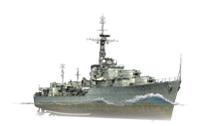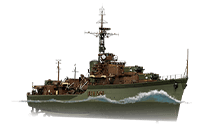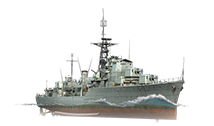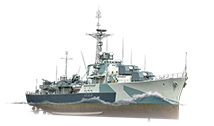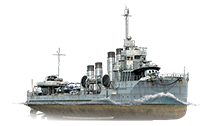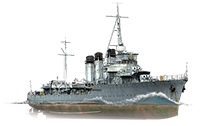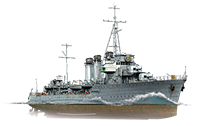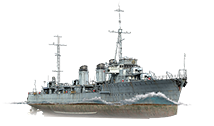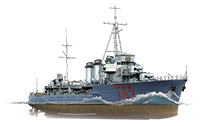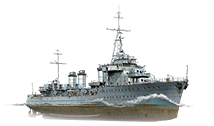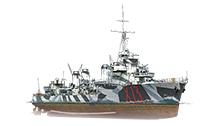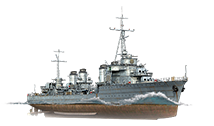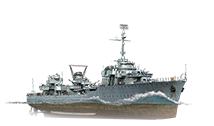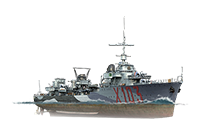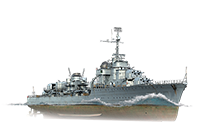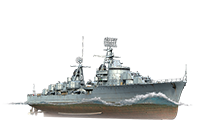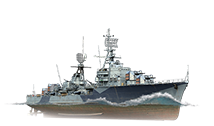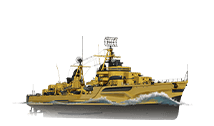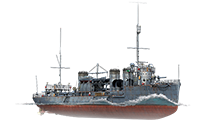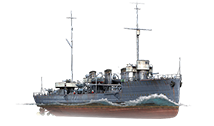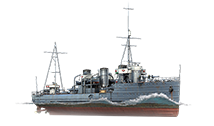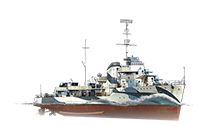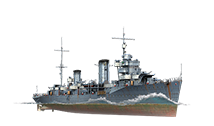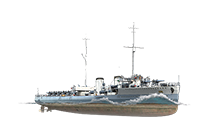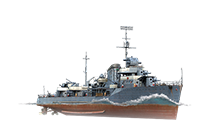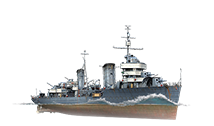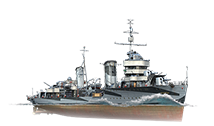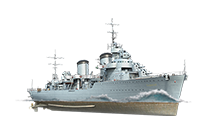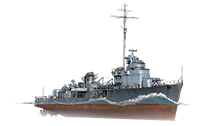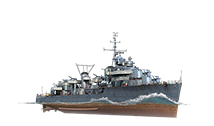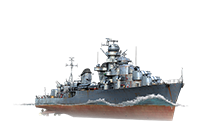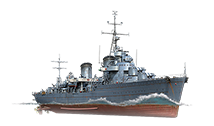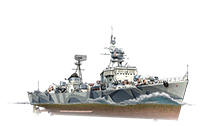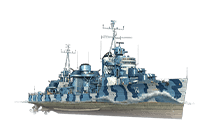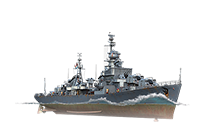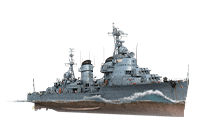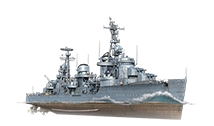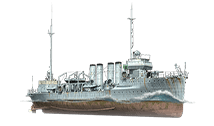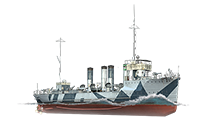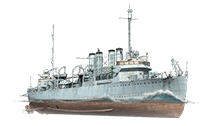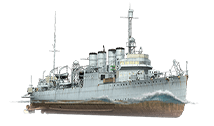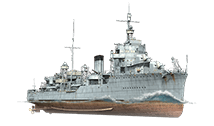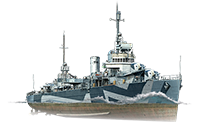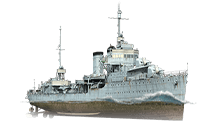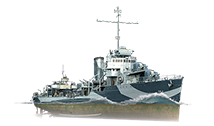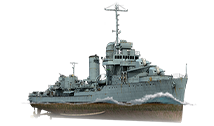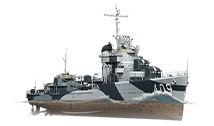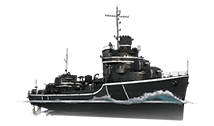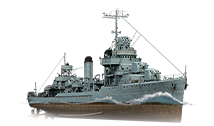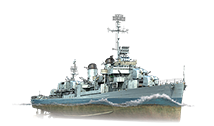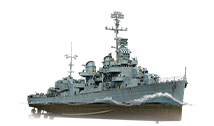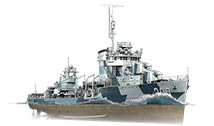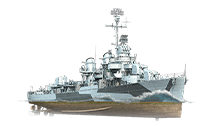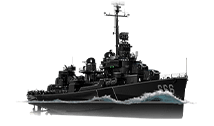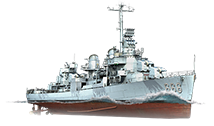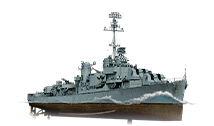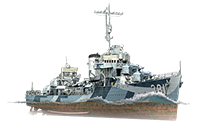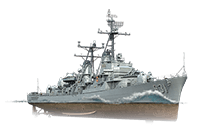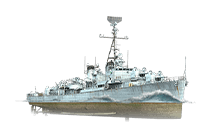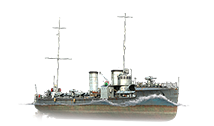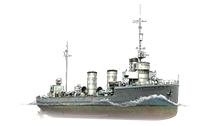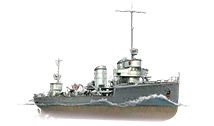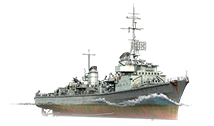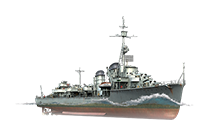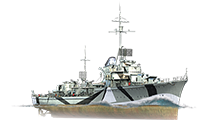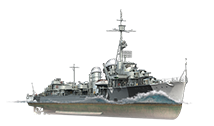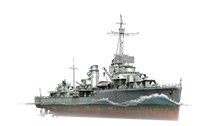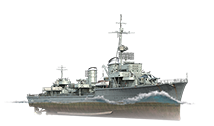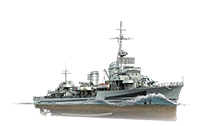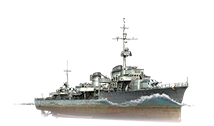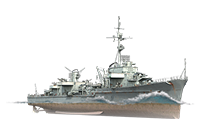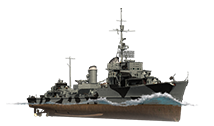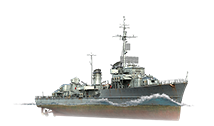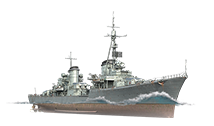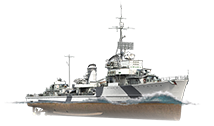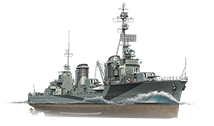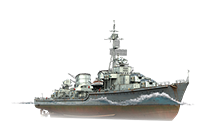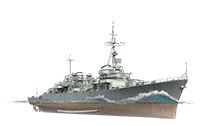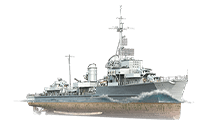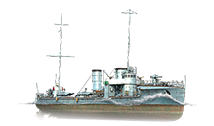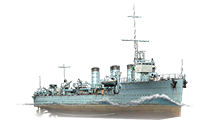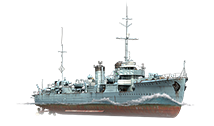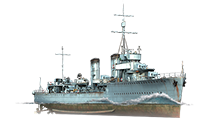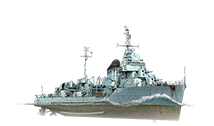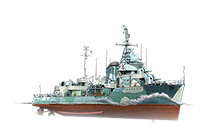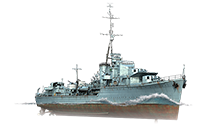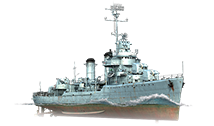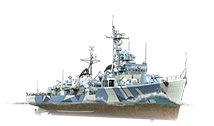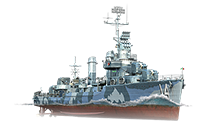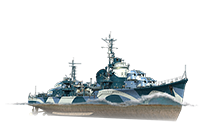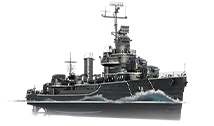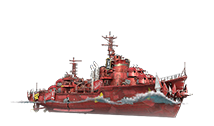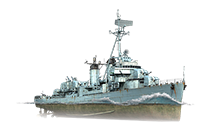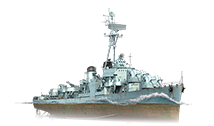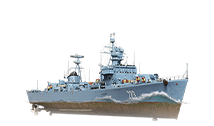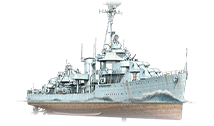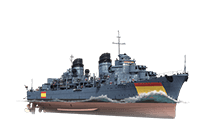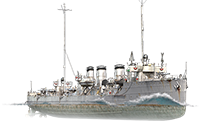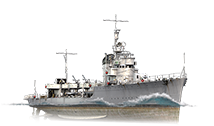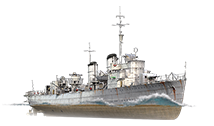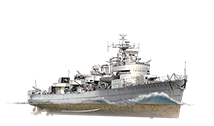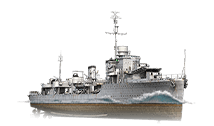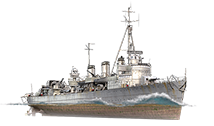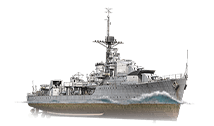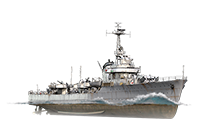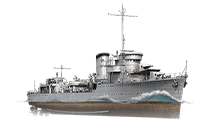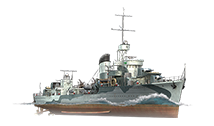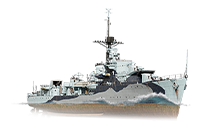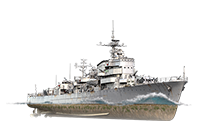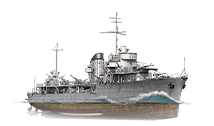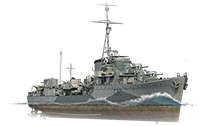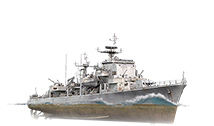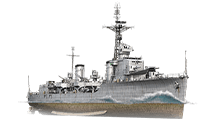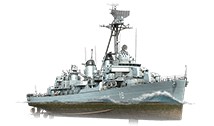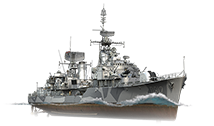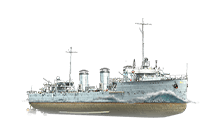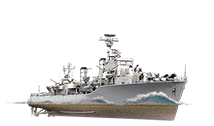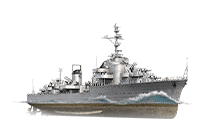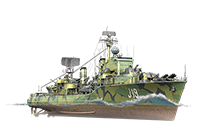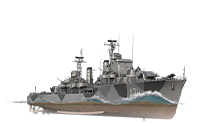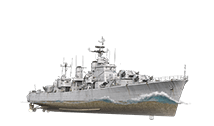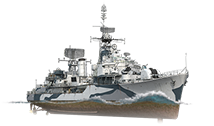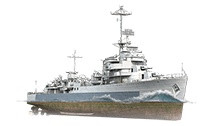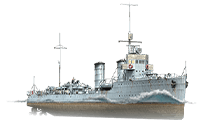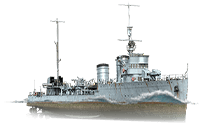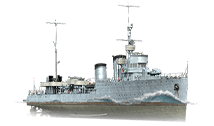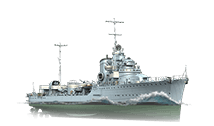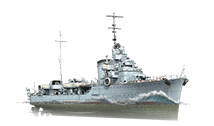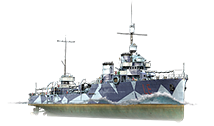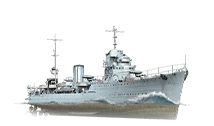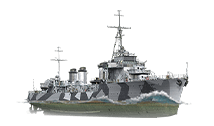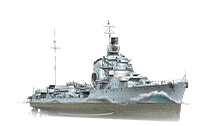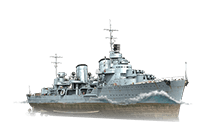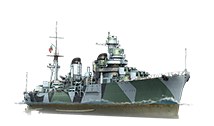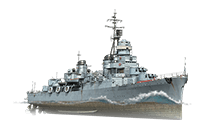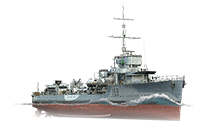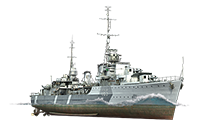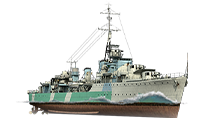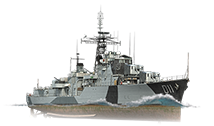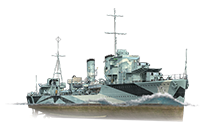Destroyers
| Revision as of 18:15, 30 March 2018 | Revision as of 02:42, 26 August 2019 | |||
One intermediate revision by one other user not shown | ||||
| Line 3: | Line 3: | |||
| |content = | |content = | |||
| [[Image:Wows-{{lc:{{#var:cur_class}}}}-icon.png|left|link=]]Small, light, and unassuming, destroyers may not be the most durable of ships, but all of them are well capable of punching many times above their weight through a deadly mix of speed, maneuverability, stealth and astounding firepower. Destroyers are versatile ships which can use either their rapid fire guns to chip away at enemies or their torpedoes to cause devastating damage. Destroyers are often called upon to scout out enemy positions, provide support — either with a [[Ship:Smoke Screens|smoke screen]] or as a distraction — and/or perform precise strikes on individual targets. | [[Image:Wows-{{lc:{{#var:cur_class}}}}-icon.png|left|link=]]Small, light, and unassuming, destroyers may not be the most durable of ships, but all of them are well capable of punching many times above their weight through a deadly mix of speed, maneuverability, stealth and astounding firepower. Destroyers are versatile ships which can use either their rapid fire guns to chip away at enemies or their torpedoes to cause devastating damage. Destroyers are often called upon to scout out enemy positions, provide support — either with a [[Ship:Smoke Screens|smoke screen]] or as a distraction — and/or perform precise strikes on individual targets. | |||
| + | ||||
| Developed in the late 19th century to combat torpedo boats (hence their original name "torpedo-boat destroyer"), they gradually took over the role of the torpedo boats themselves, but lacked speed and operating range. Over time, improvements in engine design allowed them to overcome this deficiency, and naval commanders began to utilize them more often than any other type of ship due to their new-found flexibility, lower operational costs, and ease of quick deployment. Destroyer development post-World War I was heavily influenced by the very successful ''V'' and ''W'' classes of the [[Ship:Ships_of_U.K.|Royal Navy]], although the various nations would eventually branch out into very different design philosophies brought about by the unique circumstances they found themselves in. The [[Ship:Ships_of_Japan|Imperial Japanese Navy]] in particular placed great emphasis on the development of destroyers and torpedoes, being acutely aware of Japan's numerical and industrial inferiority compared to western nations. After World War II, with the advent of long-range anti-surface and anti-air missile technology, along with the widespread use of helicopters, destroyers evolved to be the workhorse ship of modern navies throughout the world. | Developed in the late 19th century to combat torpedo boats (hence their original name "torpedo-boat destroyer"), they gradually took over the role of the torpedo boats themselves, but lacked speed and operating range. Over time, improvements in engine design allowed them to overcome this deficiency, and naval commanders began to utilize them more often than any other type of ship due to their new-found flexibility, lower operational costs, and ease of quick deployment. Destroyer development post-World War I was heavily influenced by the very successful ''V'' and ''W'' classes of the [[Ship:Ships_of_U.K.|Royal Navy]], although the various nations would eventually branch out into very different design philosophies brought about by the unique circumstances they found themselves in. The [[Ship:Ships_of_Japan|Imperial Japanese Navy]] in particular placed great emphasis on the development of destroyers and torpedoes, being acutely aware of Japan's numerical and industrial inferiority compared to western nations. After World War II, with the advent of long-range anti-surface and anti-air missile technology, along with the widespread use of helicopters, destroyers evolved to be the workhorse ship of modern navies throughout the world. | |||
| Line 10: | Line 11: | |||
| In addition, the locations of torpedo tubes falls into two main configurations: one can launch torpedoes off both sides of the ship on 360-degree swivel mounts and the other can only launch them off either sides of the ship. Both have their advantages and disadvantages: ships using 360-degree mounts have large firing arcs, can easily bring their entire torpedo arsenal to bear on a single target and escape afterwards in a "shoot-and-scoot" tactic, especially useful for destroyers, but these tubes are often exposed on the top decks and vulnerable to damage from enemy fire; tubes located along the sides of the ships are usually protected but have limited firing arcs (although this also means that the tubes spend less time turning to aim at the target as well) and the ship has to expose both sides to fully utilize her torpedoes. | In addition, the locations of torpedo tubes falls into two main configurations: one can launch torpedoes off both sides of the ship on 360-degree swivel mounts and the other can only launch them off either sides of the ship. Both have their advantages and disadvantages: ships using 360-degree mounts have large firing arcs, can easily bring their entire torpedo arsenal to bear on a single target and escape afterwards in a "shoot-and-scoot" tactic, especially useful for destroyers, but these tubes are often exposed on the top decks and vulnerable to damage from enemy fire; tubes located along the sides of the ships are usually protected but have limited firing arcs (although this also means that the tubes spend less time turning to aim at the target as well) and the ship has to expose both sides to fully utilize her torpedoes. | |||
| ? | While their purpose is nearly universal, they vary based on nationality. [[Ship:Ships_of_Japan|Japanese]] destroyers severely lack gun firepower compared to their contemporaries, are extremely fragile, and | + | While their purpose is nearly universal, they vary based on nationality. [[Ship:Ships_of_Japan|Japanese]] destroyers severely lack gun firepower compared to their contemporaries, are extremely fragile, and can do little else but attempt to flee if spotted by hostile ships; in exchange, they all can torpedo their targets beyond detection range and have the strongest torpedoes in their respective tiers. The [[Ship:Ships_of_U.S.A.|United States]] has "brawling" destroyers that have the fastest guns and a good balance of torpedoes that lack range, but nonetheless are still lethal. However, their shells take a significant amount of time to reach their target, making them ill-suited to shoot fast-moving targets at range. In addition, they are able to begin equipping the {{Defensive AA Fire}} at Tier V — normally exclusive to cruisers — making them surprisingly effective against enemy aircraft. [[Ship:Ships_of_U.S.S.R.|Russian and Soviet]] destroyers are almost light cruisers in that their primary armament is their guns — not their torpedoes, which are woefully underpowered for their respective tiers — and they lack concealment. Instead, they make up for that with incredible speeds that make them nearly impossible to hit and massive health pools that surpass other nations by far; their main battery guns are nothing to be taken lightly. Finally, [[Ship:Ships_of_Germany|German]] destroyers frequently find themselves in a middle ground between their Soviet and American counterparts, with above average stealth, good gun ballistics, and long-range torpedoes; however, slower turret traverse and rudder shift times combine with large turning circles mean they are not as difficult to hit when spotted and make them less attractive for the close-range "brawling" that the American line excels at. Their smoke screens are also the shortest lasting of any ships. They do, however, have an ace in the hole in that they gain access to the {{Hydroacoustic Search}} consumable through the latter half of the tech tree, turning them into dangerous hunters of enemies lurking in smoke. | |
| Destroyers also have 2 main consumables: {{Smoke Generator}} and {{Engine Boost}}. Smoke Generator lays down vision-obscuring smoke every few seconds, hiding the destroyer (and anything behind it) as long as the destroyer stays within the smoke for long enough to lay the next puff of smoke, or keeping the smoke screen between them and the enemy. Smoke screens however, also work both ways; they can hide the enemy if you let them go behind or into it as well. They also do not obscure the ship closer than 2 km or within the effective radius of {{Hydroacoustic Search}} or {{Surveillance Radar}}. Engine Boost increases the engine power of the destroyer by 8%, increasing its mobility and making it even more difficult to hit, assuming the destroyer has the presence of mind to perform evasive maneuvers and/or duck in and out of islands. | Destroyers also have 2 main consumables: {{Smoke Generator}} and {{Engine Boost}}. Smoke Generator lays down vision-obscuring smoke every few seconds, hiding the destroyer (and anything behind it) as long as the destroyer stays within the smoke for long enough to lay the next puff of smoke, or keeping the smoke screen between them and the enemy. Smoke screens however, also work both ways; they can hide the enemy if you let them go behind or into it as well. They also do not obscure the ship closer than 2 km or within the effective radius of {{Hydroacoustic Search}} or {{Surveillance Radar}}. Engine Boost increases the engine power of the destroyer by 8%, increasing its mobility and making it even more difficult to hit, assuming the destroyer has the presence of mind to perform evasive maneuvers and/or duck in and out of islands. | |||
Revision as of 02:42, 26 August 2019
Developed in the late 19th century to combat torpedo boats (hence their original name "torpedo-boat destroyer"), they gradually took over the role of the torpedo boats themselves, but lacked speed and operating range. Over time, improvements in engine design allowed them to overcome this deficiency, and naval commanders began to utilize them more often than any other type of ship due to their new-found flexibility, lower operational costs, and ease of quick deployment. Destroyer development post-World War I was heavily influenced by the very successful V and W classes of the Royal Navy, although the various nations would eventually branch out into very different design philosophies brought about by the unique circumstances they found themselves in. The Imperial Japanese Navy in particular placed great emphasis on the development of destroyers and torpedoes, being acutely aware of Japan's numerical and industrial inferiority compared to western nations. After World War II, with the advent of long-range anti-surface and anti-air missile technology, along with the widespread use of helicopters, destroyers evolved to be the workhorse ship of modern navies throughout the world.
Destroyers have the smallest amounts health pools, but gain some extra protection from the fact they are the only ship class in the game that does not have a citadel. This means that with any single hit from a gun, the most damage they can receive from a single shell is a full penetrating hit for 33% of a shell's nominal maximum damage. While all destroyers have excellent speed, maneuverability and concealment, their most dreaded weapon is the torpedo; their effective use is directly correlated with the effectiveness of the destroyer (each nation has their differences, however). Torpedoes can cripple or outright destroy any type and class of ship they encounter as long as they can hit them, and they do not reveal the destroyer's location when launched, making them excellent assassins. Well-placed torpedo salvos are an art form, be it having torpedoes "appear" out of nowhere, fired pre-emptively around land masses or used as area denial in narrow straits. However, unlike shells fired from guns, torpedoes have longer travel times, do not have the benefit of arcing over land masses, and as mentioned earlier, do not differentiate between friend or foe; destroyer captains should always be aware of nearby teammates such that the latter does not end up being sunk instead of the enemy.
In addition, the locations of torpedo tubes falls into two main configurations: one can launch torpedoes off both sides of the ship on 360-degree swivel mounts and the other can only launch them off either sides of the ship. Both have their advantages and disadvantages: ships using 360-degree mounts have large firing arcs, can easily bring their entire torpedo arsenal to bear on a single target and escape afterwards in a "shoot-and-scoot" tactic, especially useful for destroyers, but these tubes are often exposed on the top decks and vulnerable to damage from enemy fire; tubes located along the sides of the ships are usually protected but have limited firing arcs (although this also means that the tubes spend less time turning to aim at the target as well) and the ship has to expose both sides to fully utilize her torpedoes.
While their purpose is nearly universal, they vary based on nationality. Japanese destroyers severely lack gun firepower compared to their contemporaries, are extremely fragile, and can do little else but attempt to flee if spotted by hostile ships; in exchange, they all can torpedo their targets beyond detection range and have the strongest torpedoes in their respective tiers. The United States has "brawling" destroyers that have the fastest guns and a good balance of torpedoes that lack range, but nonetheless are still lethal. However, their shells take a significant amount of time to reach their target, making them ill-suited to shoot fast-moving targets at range. In addition, they are able to begin equipping the Defensive AA Fire ![]() at Tier V — normally exclusive to cruisers — making them surprisingly effective against enemy aircraft. Russian and Soviet destroyers are almost light cruisers in that their primary armament is their guns — not their torpedoes, which are woefully underpowered for their respective tiers — and they lack concealment. Instead, they make up for that with incredible speeds that make them nearly impossible to hit and massive health pools that surpass other nations by far; their main battery guns are nothing to be taken lightly. Finally, German destroyers frequently find themselves in a middle ground between their Soviet and American counterparts, with above average stealth, good gun ballistics, and long-range torpedoes; however, slower turret traverse and rudder shift times combine with large turning circles mean they are not as difficult to hit when spotted and make them less attractive for the close-range "brawling" that the American line excels at. Their smoke screens are also the shortest lasting of any ships. They do, however, have an ace in the hole in that they gain access to the Hydroacoustic Search
at Tier V — normally exclusive to cruisers — making them surprisingly effective against enemy aircraft. Russian and Soviet destroyers are almost light cruisers in that their primary armament is their guns — not their torpedoes, which are woefully underpowered for their respective tiers — and they lack concealment. Instead, they make up for that with incredible speeds that make them nearly impossible to hit and massive health pools that surpass other nations by far; their main battery guns are nothing to be taken lightly. Finally, German destroyers frequently find themselves in a middle ground between their Soviet and American counterparts, with above average stealth, good gun ballistics, and long-range torpedoes; however, slower turret traverse and rudder shift times combine with large turning circles mean they are not as difficult to hit when spotted and make them less attractive for the close-range "brawling" that the American line excels at. Their smoke screens are also the shortest lasting of any ships. They do, however, have an ace in the hole in that they gain access to the Hydroacoustic Search ![]() consumable through the latter half of the tech tree, turning them into dangerous hunters of enemies lurking in smoke.
consumable through the latter half of the tech tree, turning them into dangerous hunters of enemies lurking in smoke.
